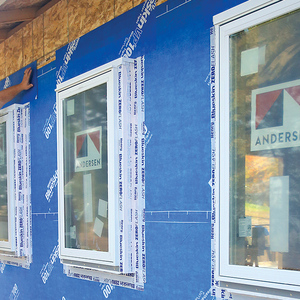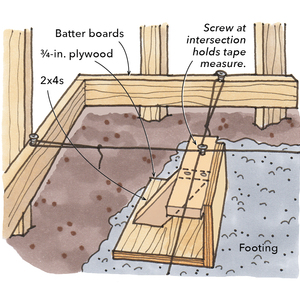Can someone explain what I saw in the breaker box today?
Customer wants a convenience outlet in closet for cable box and other video equipment that are on shelf; presently powered by a pair of extension cords stretched across the room.
I found a 12-2 NM cable in attic above that might be cut and spliced in a J-box as a source of power for the new outlet, but here is the strange part: It is part of a group of 4 20A breakers whose toggles are joined together by a snap-on bar. What would the reason be to join 4 breakers together?
Stranger yet, when I separated the breakers to find out which had the circuit I wanted, I found that TWO of those breakers (2nd and 4th of the quartet) both power the same outlet (I don’t know how many others are affected) That outlet has one 12-2 with ground running down to it from the attic and another 12-2 exiting the box but staying within the wall – presumably part of a daisy chain.
Should the homeowner be worried about two breakers feeding one circuit? If there were an overload, would the breakers share the load thereby allowing the wires to overheat, or would both trip?
I’m guessing that somehow last outlets of two adjacent branch circuits were connected by someone in a hurry as part of a “daisy chain”.
Thanks for the help
BruceT




















Replies
How did you test the circuit for voltage? One possibility is that you're reading phantom voltage on a multi-wire circuit. A multiwire circuit (shared neutral) would explain two breakers with handle ties, but in most panels they would be adjacent full-size breakers.
I suggest you measure voltage between the 2nd and 4th breaker, using a solenoidal tester (wiggy or equivalent). Also use a wiggy to test voltage at the closet receptacle to confirm that the outlet is indeed fed by two breakers.
If the receptacle is fed by two breakers on the same leg or pole, then the conductors could overload, and it is a dangerous situation.
There is a kind of breaker called a "twin tandem" or "over-under" breaker, which is four breakers in two full size spaces with handle ties between the two inner breakers and the two outer ones. This gives you two 240V branch circuits or two multiwire circuits n the space of two full size breakers. I can't imagine a situation where 4 single pole breakers are tied together.
Any chance of posting a photo?
Cliff
There could be another thing happening here. There might be a 240 load between the 2 breakers. Maybe some AC units."There is a kind of breaker called a "twin tandem" or "over-under" breaker, which is four breakers in two full size spaces with handle ties between the two inner breakers and the two outer ones. This gives you two 240V branch circuits or two multiwire circuits n the space of two full size breakers. I can't imagine a situation where 4 single pole breakers are tied together."I have always heard they called Quad breakers.Here is a picture of one.http://tinyurl.com/lzav3I wonder how reliable that tie bar is for the outer two poles.Now here is another quad, but it is 2 single poles, and a 2 pole.http://ecatalog.squared.com/catalog/173/html/sections/06/17306009.html
HOMT at the bottom.But the realative spacing of the handles makes it appear that they are not separate (at least from this picture).
I tested by plugging the vacuum cleaner in and listening for it to stop running when I shut off the correct breaker. The vacuum cleaner ran when either or both of the 2nd and 4th breakers was on. The breakers in question are 4 full size ones. There are also several breakers in the box that occupy two spaces, with a narrow 240 pair in the center and two independant ones outside those. I wish I'd thought to take a photo.BruceT
The vacuum test is pretty definitive. I'd tell the HO what's going on,
turn off the two feeder breakers, use a tester to see where in the
house the feeds go, and break the loop somewhere that makes sense.
Make sure the break is permanent and can't be un-done. Maybe even put a note in the box. If possible, remove a segment of wire. Your splice
point in the attic may be a good place to cut the loop, but then again it may be too near one end of the loop...I'd spend a half-hour doing it, and tell the HO its a freebie. Also
he may have similar issues elsewhere, and that someone should look
for them.-- BrooksBTW, This is a huge safety issue. Someone may throw a breaker, expect
the wires to be dead, and whammo!
Edited 8/24/2006 10:07 am ET by Brooks
"I'd tell the HO what's going on,
turn off the two feeder breakers, use a tester to see where in the
house the feeds go, and break the loop somewhere that makes sense.
Make sure the break is permanent and can't be un-done. Maybe even put a note in the box. If possible, remove a segment of wire. Your splice
point in the attic may be a good place to cut the loop, but then again it may be too near one end of the loop..."It may take more than that.It is very possible that this is a multi-wire circuit "gone bad".If just the cross connection was removed the neutral could still be overloaded as the feeds apear to be on the same hot leg (2 & 4th breaker). Found that problem in my own home. Took 2 breakers to turn off the furnaces. I have two side by side and one 14-3 was run to the furnaes. Later, I suspect the furnace installers - but no proof, connected the two hots together and feed one disconeect to the two furnaces. Then moved the breakers so that they where on the same leg.Really best to disconnect everything and then find what is what and put it back correctly.There is also the quesiton of what is on the other 2 breakers and why all four are tied together.
Thanks for the suggestion.What's your best trick for finding which outlets are on a particular breaker? I understand the rule of halves for locating a break in a branch of known outlets, but is there a clever way to trace out a branch circuit without testing every outlet in the house? I know that bathrooms are sometimes all on the same branch so only one GFCI is needed, and Kitchens tend to be on separate circuits, but what is the usual pattern for outlet circuits in living spaces? "splice point in the attic may be a good place to cut the loop, but then again it may be too near one end of the loop..."
If I have two branches from separate breakers with their respective ends joined to form a loop, how can I determine which outlets are near the ends?Thanks,BruceT
As I mentioned to CAP it is possible that there was a 240 load on that circuit...Stop if it was the 2 & 4 breakers on most panel they would be on the same leg.Did the tie bar that tied all of them together look like it was factory or did someone just stick a nail in it.Something that screwed up it is best to assume that everything is wrong and to disconnect all and then put it back to one circuit at a time and testing each one as you go along.Once you get into it you might find some "logic" to what was done.
I thought of the 240 load idea, but since the NM is 12-2, wouldn't it cause an immediate overload if one breaker were connecting leg A and the other leg B on opposite ends of the same black wire with no resistance in between? I went back and took pictures. It's a Square-D All-in-One panel. Four breakers tied together with a factory-made connector bar (see pic).BruceT
Does that 2nd breaker have a "200" on it?TFB (Bill)
Those are TWO HUNDRED AMP MAIN BREAKERS, no 20 amp breakers.I don't know why some large breakers are made like and I don't know how they feed there loads.But it looks like this is a split bus panel. With the 240 volt loads below and the 120 above. Typically those have a "main" breaker for the 120 loads and then upto 5 more 240 breakers that are directly connected to the service feeders. IE, no one breaer kills all of the power.But in those cases "main" breaker would typically be much less than 200 amps as it only supplies the 120 loads.But looking at the picture of the whole panel, if it is a split bus panel it is not setup right. There are two quad breakers below which should not be used without a main. As one quad breaker has 3 handles and you are allowed a max of 6 to turn off ALL POWER.Maybe CAP is more familar with that style of panel.But I also notice that there are 7 240 breakers. 3 regular 2 pole and 4 quad breakers. That is a lot unless they either have electric resistance heat or there are a number of multi-wire circuits.Now back to your orginal problem. How where you turning the individual breakers on an off. Where you able to remove the tie bar?Now it makes sense that you would have to turn both off as it appears that the poles on the main breaker are paralleled. My speculation is that each section is rated for 100 amps.Now if those are the ONLY two breakers that will turn off the circuit that means that hot wired directly to the bus with 200 amps of feed and that needs to be fixed.But you might have anyother combination of cross coupled circuit.Start with turning off ALL breakers except the mains. If it is hot them it is feed direct from the buss or tapped off the mains breaker.If not try flipping one breaker at a time on and then off and noting which one(s) control that circuit."What's your best trick for finding which outlets are on a particular breaker? I understand the rule of halves for locating a break in a branch of known outlets, but is there a clever way to trace out a branch circuit without testing every outlet in the house?"There are $39.99 kits that you can get at most home horror stores that used for Circuit Breaker Identification.http://tinyurl.com/k85y9Now I have found that it does not allways (more accurately rarely) can pinpoint a specific breaker. But you if you turn up the sensitivity you know which one it is because it stops beeping when you turn off that breaker.And you can put the receive within a couple of inches a receptacle or switch on the circuit with the transmitter and it will beep. I don't have any experience with this, but I suspect that if it happened to be on a multi-wire circuit that it is very possible that enopugh signal would be couple into the other leg and even if it is split off at some point that it would also indicate that it is on that circuit, but it might not.So just do some double checking with potential multi-wire circuits.However, I have found that with that unit that it also puts out inteference that would show up on a pocket AM radio. And that is more sensitive. You only need to get the radio within a couple of ft of the receptacle. Then after turning off the circuit I verify each of the one that appeared to be on that circuit with a non-contact voltage probe (tick tester). Past the only all in one GFCI circuit (bathroom, outside, and garage) most circuits are wired to one more adajecent rooms and possible on those receptacle on the other side of the walls from those room(s).There are some more expensive versions of the circuit breaker traces.http://tinyurl.com/hey38And people have said that they will pick out the correct breaker. But I have no idea if the range is such that you can use it to also ID other receptacels on the circuit, but it should. And I don't know if the trick with the radio will work or not.
Sure looks like it says 200 to me, too! Looking at the positioning of
the meter, I wonder if the meter feeds ~400A to the breaker-side of
the box, and the 4 200A breakers at the center are the disconnects
for the upper and lower half of the box.That documentation shown on the back of the door may tell the story...BrooksEdit: Electric heat? Otherwise, why so much power?
Edited 8/25/2006 3:06 pm ET by Brooks
Well Square D does make that series, with in 400 amp.But none of them have 20 slots which this one does.http://ecatalog.squared.com/catalog/173/html/sections/01/17301014.html#1046905
http://ecatalog.squared.com/catalog/173/html/sections/01/17301015.html#1009030Now this is a 20 slot, Homeline unit.You can see the HOMT on the one tandem breaker.However there are a couple of different 20 slot units.But when you look at the configuration of the meter and breakers
only the SC2040M20C matches.http://ecatalog.squared.com/catalog/173/html/sections/01/17301017.html#1011409And that uses a HOM2200 as the main disconnect.http://breakerbunch.com/content/p/8/pid/1373/catid/528/HOM2200It is an 2 pole, 200 amp disconnect and a 200 amp panel.Don't know why the breakers are configured like they are.
.." Don't know why the breakers are configured like they are. "I think they are made like that due to the design of the bus..I don't have a clue as to why SqD doesn't bolt them on to the mains like the QOs.....sure makes it hard to run the smaller wires past the big feeders...especially for all those other tandems.....
.
.
.Wer ist jetzt der Idiot
?
Thank you for your patience and help. Yes, the plastic link can be pried off those 4 main breakers.The light wasn't so good and 20 was what I expected to see on that sized breaker so I totally missed the 200 until I looked at the picture. The flash made that number stand out well.Bottom breaker is 100 A, so I took that for main.If that is a split panel but both sides of the main are locked together, could it bve that both halves are tied together?I'll look further for another breaker. When I went back to take pictures I noticed a subpanel in the garage where the labeled breakers were all garage outlets and lights, but maybe one of the unlabeled ones controls the circuit I want to use.Thanks again for your help.BruceT
"If that is a split panel but both sides of the main are locked together, could it bve that both halves are tied together?"See my post to Brooks.I *think* that the all of the buses are tied togehter and that it is NOT a split buss of the type where there is no single main.But I have no idea why the main breaker is made like that.